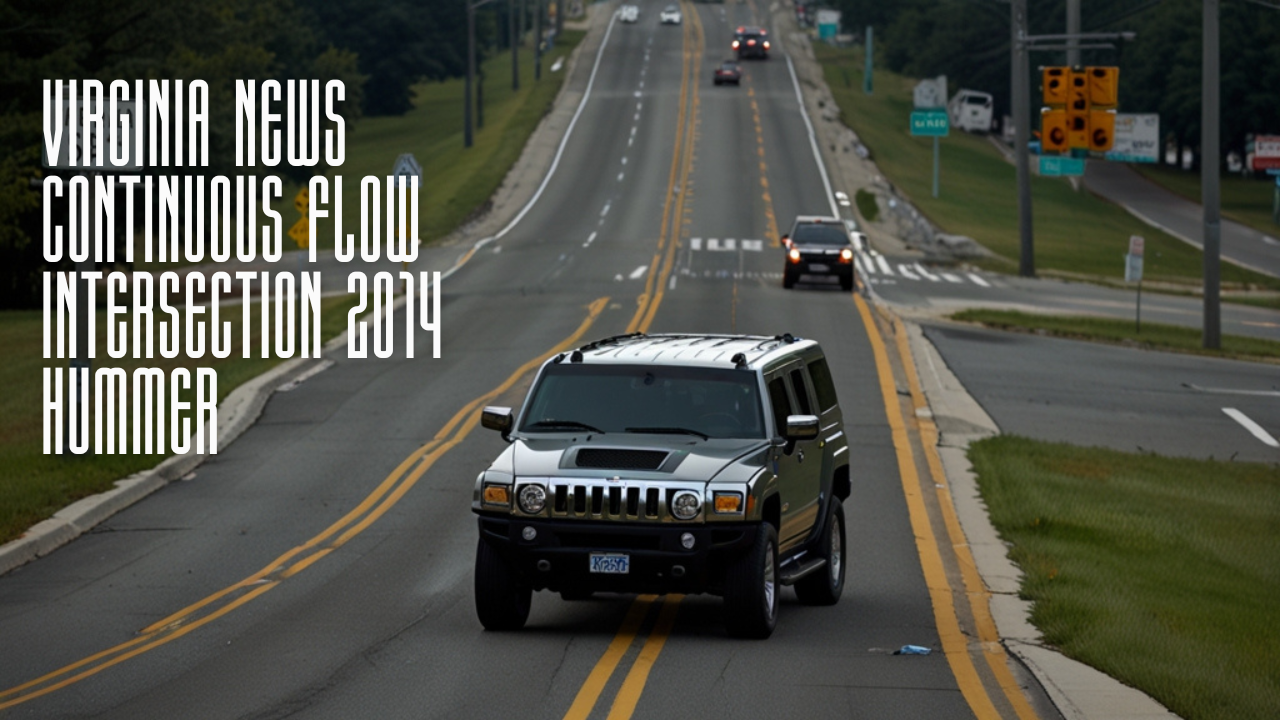Introduction
With the rapid growth of urban areas and increasing traffic congestion, finding innovative ways to manage vehicle flow is a top priority for city planners and engineers. One standout solution for making waves is the Continuous Flow Intersection (CFI). Highlighted in Virginia News Continuous Flow Intersection 2014 Hummer, this cutting-edge design is revolutionising traffic management. CFIs have proven effective in reducing delays and improving traffic efficiency, even for large vehicles like the 2014 Hummer. This article dives into the mechanics of CFIs, their impact on communities, and how they accommodate oversized vehicles, showcasing how Virginia is at the forefront of traffic innovation.
Table of Contents
What is a continuous flow intersection?

A continuous flow intersection is an advanced traffic design created to reduce congestion and improve vehicle flow. Unlike traditional intersections, CFIs allow for certain vehicle movements—particularly left turns—before drivers reach the main intersection. This preventive approach eliminates the need to wait for traffic lights to change, significantly reducing delays and bottlenecks.
In regions like Virginia, where rush-hour traffic can be overwhelming, CFIs have been instrumental in easing vehicle flow. The Virginia News Continuous Flow Intersection 2014 Hummer story exemplifies how even larger vehicles, often challenging to manoeuvre in congested areas, can benefit from this innovative infrastructure.
Virginia’s Commitment to Traffic Solutions

Virginia has established itself as a leader in traffic and infrastructure innovation. The state’s proactive approach to tackling congestion includes adopting CFIs in high traffic areas. These intersections have become a focal point in the local news, highlighting Virginia’s dedication to improving daily commutes for residents.
The 2014 Hummer, a large and powerful vehicle, often serves as a litmus test for the functionality of CFIs. Initial concerns from drivers about whether such intersections could accommodate oversized vehicles have been addressed through real-world testing and user experiences. Reports have shown that CFIs effectively manage all types of vehicles, including the Hummer, ensuring safe and efficient navigation.
How Continuous Flow Intersections Work
The primary innovation of a CFI lies in its handling of left-turning traffic. Traditional intersections often experience delays due to left-turning vehicles waiting for green arrows or gaps in oncoming traffic. CFIs eliminate this issue by enabling left turns before the main intersection.
For example, a driver in a 2014 Hummer approaching a CFI would enter a left-turn lane well ahead of the intersection. This dedicated lane guides the vehicle to a designated crossing point, allowing it to safely traverse opposing traffic before reaching the primary intersection. By completing the turn in advance, the vehicle bypasses the usual waiting time, reducing congestion and minimising potential conflicts with other drivers.
The Benefits of CFIs in Virginia
The adoption of continuous flow intersections in Virginia has delivered numerous benefits:
Reduced Congestion: By allowing vehicles to make preemptive left turns, CFIs minimise traffic buildup at intersections, especially during peak hours.
Enhanced Safety: CFIs streamline traffic movements, reducing the likelihood of collisions caused by left-turn conflicts.
Time Savings: Drivers experience shorter wait times, leading to quicker commutes.
Adaptability: CFIs accommodate vehicles of all sizes, from compact cars to larger models like the 2014 Hummer.
Virginia News Continuous Flow Intersection 2014 Hummer: A Revolutionary Pairing for Smooth Traffic Flow
The 2014 Hummer has long been recognised for its robust design and unparalleled off-road capabilities. Its iconic build and performance make it a popular choice among drivers seeking reliability and strength. However, its large size can present challenges, especially in urban areas with heavy traffic. Navigating tight spaces and executing wide turns often becomes cumbersome. Fortunately, the introduction of continuous flow intersections (CFIs) in Virginia has transformed the driving experience for Hummer owners, making city navigation smoother and more efficient.
Continuous Flow Intersection: A Solution for Large Vehicles
Virginia’s implementation of continuous flow intersections (CFIs) addresses a common pain point for drivers of large vehicles like the 2014 Hummer. Unlike traditional intersections, CFIs eliminate the need for left-turning vehicles to cross opposing traffic lanes. This innovative design prioritises a seamless flow, reducing congestion and enhancing road safety.
For Hummer drivers, CFIs provide wider lanes and preemptive left-turn signals, making it easier to navigate through intersections without impeding traffic. This efficiency has made CFIs a standout feature in Virginia’s traffic management, earning praise from both local residents and the media.
Virginia News Highlights the Benefits of CFIs for the 2014 Hummer
Local news outlets have extensively covered the advantages of CFIs, with the Virginia News Continuous Flow Intersection 2014 Hummer becoming the focal point of many discussions. Reports emphasise the following key benefits:
Smoother Left Turns
The preemptive left-turn design of CFIs allows Hummer drivers to execute turns more smoothly, reducing the need for wide and cumbersome manoeuvres. This feature is particularly advantageous for vehicles with a larger turning radius.
Reduced Congestion
Traditional intersections often create bottlenecks, especially during peak hours. CFIs’ ability to maintain a continuous flow of traffic ensures that even larger vehicles like the Hummer can move efficiently through intersections without causing delays.
Shorter Wait Times
CFIs prioritise traffic flow by allowing vehicles to make left turns before entering the main intersection. This reduces waiting times at red lights, an improvement that Hummer owners have found to be a game-changer.
Improved Safety
One of the most significant advantages of CFIs is enhanced road safety. By eliminating the need for vehicles to cross multiple traffic lanes, the risk of collisions is greatly reduced. For larger vehicles like the 2014 Hummer, this safety feature is particularly beneficial.
How CFIs Enhance the Driving Experience for Hummer Owners
The 2014 Hummer, with its imposing size and powerful performance, thrives in environments where space and design accommodate its unique requirements. CFIs provide several advantages that make driving this vehicle in Virginia’s urban areas far more manageable:
Wider Lanes
CFIs feature wider lanes specifically designed to accommodate larger vehicles. This ensures that Hummer drivers can navigate tight turns and merge seamlessly without encroaching on adjacent lanes.
Fuel Efficiency
By reducing idle times at intersections, CFIs contribute to improved fuel efficiency. Hummer owners have reported noticeable savings in fuel consumption, thanks to the reduced stop-and-go driving pattern.
Stress-Free Navigation
Navigating congested urban areas can be stressful for drivers of large vehicles. The streamlined design of CFIs minimises this stress, offering a smoother and more predictable driving experience.
Virginia News Coverage: A Testimony to Success
Virginia News has frequently highlighted the transformative impact of CFIs on local traffic management. Reports underscore how these intersections have reduced congestion, enhanced safety, and improved travel times for all vehicle types—including large SUVs like the 2014 Hummer. Driver testimonials further validate these findings, with many praising CFIs for making urban navigation less challenging and more enjoyable.
Virginia News Continuous Flow Intersection 2014 Hummer: Challenges and Future Improvements
The Virginia News Continuous Flow Intersection 2014 Hummer story stands as a beacon of innovation in traffic management. By revolutionising how intersections are designed, Virginia has demonstrated a forward-thinking approach to reducing congestion and enhancing road safety. While these intersections are effective, they also present unique challenges and opportunities for future enhancements.
Challenges of Continuous Flow Intersections
Continuous Flow Intersections (CFIs) have gained attention for their ability to streamline traffic flow, but they aren’t without their hurdles. Drivers encountering a CFI for the first time often find the layout unfamiliar compared to traditional intersections. This initial confusion can lead to hesitation or errors in navigation, which undermines the intended efficiency.
To address this, experts suggest increased investment in public education campaigns. Informative materials, videos, and interactive simulations can help familiarise drivers with CFIs before they encounter them. Additionally, clearer and more intuitive signage at these intersections could provide on-the-spot guidance, reducing uncertainty and enhancing the overall driving experience.
Another challenge lies in accommodating large vehicles. While CFIs are engineered to handle heavy traffic and larger vehicles, space constraints at certain intersections can create difficulties for oversized vehicles like the 2014 Hummer. In such cases, tailored infrastructure upgrades, including wider lanes or reinforced turning areas, may be necessary to ensure smooth navigation and avoid bottlenecks.
Future Improvements and Innovations
The success of the Virginia News continuous flow intersection in 2014 highlights the importance of continuous innovation in urban planning. As urban areas expand and traffic volumes increase, it’s crucial to anticipate future demands and enhance CFI designs accordingly. Incorporating advanced technologies, such as smart traffic signals and vehicle-to-infrastructure (V2I) communication systems, could further optimise traffic flow and reduce delays.
For instance, integrating sensors and AI-powered systems at CFIs could enable real-time traffic monitoring and dynamic signal adjustments. These enhancements would ensure that vehicles like the 2014 Hummer and others experience minimal interruptions, even during peak hours. Moreover, expanding CFI networks to high-density urban areas and busy highways could significantly reduce congestion across the state.
The Virginia News Continuous Flow Intersection 2014 Hummer: A Model for Success
The introduction of continuous flow intersections in Virginia marks a pivotal shift in traffic management. By prioritising the seamless movement of vehicles, CFIs offer a blueprint for solving some of the most pressing urban transportation challenges. The Virginia News Continuous Flow Intersection 2014 Hummer case exemplifies how these intersections can effectively handle large vehicles, proving their versatility and efficiency.
This success story is a reminder that innovative infrastructure solutions can transform the way we approach traffic congestion. The 2014 Hummer, navigating Virginia’s CFIs with ease, underscores the importance of designing roadways that cater to a diverse range of vehicles.
FAQs
What is the significance of the Virginia News Continuous Flow Intersection 2014 Hummer case?
The Virginia News Continuous Flow Intersection 2014 Hummer highlights how advanced traffic designs like CFIs improve traffic efficiency and accommodate large vehicles like the 2014 Hummer. This case showcases Virginia’s commitment to innovative traffic solutions that enhance safety and reduce congestion.
How do continuous flow intersections benefit larger vehicles like the 2014 Hummer?
CFIs feature preemptive left-turn lanes and wider roads, allowing large vehicles such as the 2014 Hummer to navigate intersections smoothly without causing bottlenecks. These designs reduce waiting times and improve manoeuvrability for oversized vehicles.
Are continuous flow intersections common in Virginia?
Yes, Virginia has adopted CFIs in many high-traffic areas as part of its initiative to improve urban transportation. These intersections have been widely recognised for their effectiveness in managing traffic flow and reducing congestion.
What challenges do drivers face when using continuous flow intersections for the first time?
New drivers may find the layout of CFIs unfamiliar compared to traditional intersections, leading to initial confusion. Increased public education and clear signage can help mitigate this challenge.
Can CFIs be further improved to accommodate future traffic demands?
Yes, future improvements such as integrating smart traffic signals, AI-powered systems, and vehicle-to-infrastructure communication can optimise CFIs. These advancements will enhance efficiency and reduce congestion, even as traffic volumes increase.
Conclusion
The Virginia News Continuous Flow Intersection 2014 Hummer case underscores the transformative impact of innovative traffic designs like Continuous flow intersections. By enabling smoother traffic flow, reducing congestion, and accommodating larger vehicles such as the 2014 Hummer, CFIs represent a breakthrough in urban planning.
Virginia’s commitment to these cutting-edge solutions highlights the importance of adapting infrastructure to meet evolving traffic demands. As CFIs continue to gain traction, their potential for reducing travel times, enhancing safety, and supporting diverse vehicle types positions them as a model for modern traffic management. With ongoing improvements and technological integration, CFIs promise to play a crucial role in shaping the future of transportation.
For any kind of updates please visit Mywape



